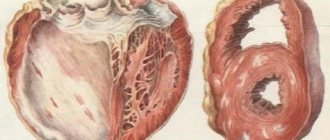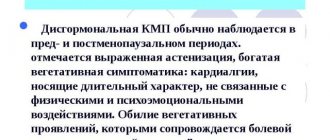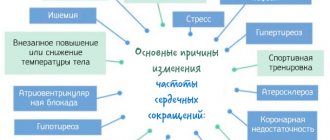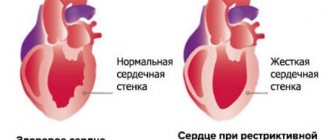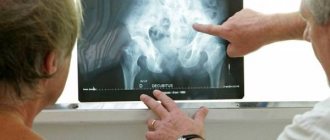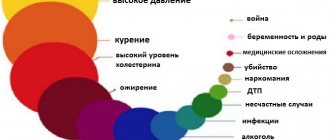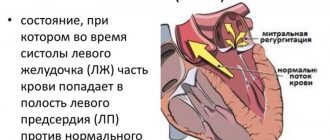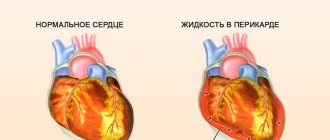Definition and reasons
Exposure to toxic agents
Cardiomyopathy (CM) is a term that you don't hear about very often. To many he says absolutely nothing. In medicine, the concept of cardiomyopathy includes a whole group of heterogeneous diseases in which the heart muscle, the myocardium, is damaged. The disease is accompanied by dysfunction and structure of the heart muscle. In this case, there is no damage to the valve apparatus, coronary arteries, there is no arterial hypertension and congenital diseases that could become causative factors in such structural and functional changes.
The definition of “toxic” means the development of a disease due to exposure to toxic agents. What can have a toxic effect on the myocardium? Unfortunately, it is not only alcohol or drugs that have a detrimental effect on the heart muscle. Within the framework of toxic cardiomyopathy, the following possible causes are distinguished:
- alcohol,
- narcotic substances,
- medicinal substances (antitumor, cardiac glycosides),
- heavy metals and industrial poisons (cobalt, lead, mercury, cadmium, etc.),
- exposure to radiation.
Some features of the appearance and development of pathology
The disease affects all age groups, regardless of gender or race. With the development of the dosage form, chronic intoxication occurs as a result of exposure to the body of inorganic salts, opiates, alkaloids and lactones. The development of the radiation form is associated with the negative influence of radiation from certain metals and substances.
Most often, the pathology manifests itself in patients suffering from cancer, undergoing radiation therapy and traditional chemotherapy treatment. A distinct toxic cardiomyopathy is observed when the body is poisoned with barium chloride, opiates in combination with ethanol (or ethyl alcohols), as well as such alkaloids and lactones as:
- quinine;
- aconitine;
- veratrine;
- coumarin;
- pachycarpin.
The severity of poisoning depends on the duration and severity of intoxication. One of the late manifestations of pathology is an acute disruption of the normal process of nutrition of heart tissue and dystrophic damage to the heart muscle, which inevitably leads to premature death. Toxic cardiomyopathy is characterized by an increase in the size and weight of the heart due to hypertrophy of the walls of the right and left ventricles, a decrease in the amount of cardiac fiber and expansion of the cardiac cavities. In this case, a decrease in the values of the cardiac, atrial and ventricular indices is observed, since functional and, in particular, structural changes interfere with the normal functioning of the organ.
Pathogenesis of toxic CMP
Heart failure
The impact of toxic agents on the myocardium does not pass without leaving a trace. Let's look at some of the mechanisms of the damaging effects of toxins on the myocardium. Once in the body, toxic substances have a direct damaging effect on the cells of the heart muscle. In cardiomyocytes, an imbalance occurs between the processes of excitation and contraction due to ionic imbalance. Cells lose potassium, becoming overloaded with calcium ions.
Muscle cells overloaded with calcium are unable to contract. The next mechanism of toxic influence is the disconnection and disruption of energy production processes in cells. As a result, granules are activated, which destroy the cardiomyocyte from the inside, dooming it to death. Finding themselves in such conditions, a certain part of the cardiomyocytes dies, losing their ability to contract. In response to the current “emergency” situation, neighboring undamaged cells begin to hypertrophy, working for “two”.
In this regard, uneven hypertrophy is observed in the thickness of the myocardium, along with which there are areas of “stretched” cells that have lost their contractility. In this condition, the ability to contract the myocardium of the left and right ventricles is reduced. In toxic cardiomyopathy, not only the ventricles, but also the atria are affected. The heart gradually loses its pumping function, and heart failure develops.
Risk factors for developing toxic cardiomyopathy
Along with the main cause - intoxication of the body, risk factors play an important role in the development of pathology. First of all, these include smoking, which has the most negative effect on the human body. Other risk factors include:
- alcohol abuse;
- drug use;
- the occurrence of infectious diseases in the body;
- lack of vitamin B;
- inflammatory damage to the glands and pituitary gland;
- transfer of endocrine diseases;
- damage by scleroderma;
- heavy metal intoxication;
- inadequate filling of the heart cavities with blood mass due to vascular damage;
- persistent disruption of the normal heart rhythm;
- drug intoxication.
Alcoholism significantly increases the risk of developing toxic cardiomyopathy.
In most cases, intoxication with medical drugs is observed during self-medication, since without professional help it is not always possible to determine a safe dose of the drug. Before using potent substances, you should consult a specialist! Incorrect introduction of certain medications into the body can cause a sharp deterioration in overall health.
Clinic
"Cancel" state
For a long time the disease does not manifest itself with any symptoms. Obvious clinical signs of heart failure are preceded by a so-called asymptomatic period. Patients may present nonspecific complaints due to the effects of toxic substances on the heart. They may be concerned about increased fatigue, general weakness, shortness of breath and a feeling of palpitations and pain in the heart area during physical activity.
Patients usually notice this condition the next day after contact with toxic substances. This is explained by the fact that the body is in a state of “withdrawal”. After a longer time, these complaints subside and disappear completely. However, with continued exposure to toxic substances, such sensations do not go away completely. Moreover, they can become permanent and intensify, which is explained by the progression of heart failure.
Interruptions in heart function and shortness of breath accompany not only physical activity, but also any mode of physical activity. Other signs of right ventricular heart failure are added - swelling of the lower extremities, cardiac asthma appears, accompanied by attacks of suffocation. Pain in the heart region with cardiomyopathy differs from that with coronary heart disease. The pain is mild, localized in the heart area, and can be either short-term or long-lasting. Nitroglycerin does not relieve pain from cardiomyopathy.
Thyreotoxic cardiomyopathy: the factors of risk and predictors of development
The mechanisms of thyroid hormones (TH) action on the myocardium and basic clinical manifestations of thyrotoxic cardiomyopathy (TCMP) are described. The introduction into the concept of TCMP and analysis of the incidence of the most common different manifestations of TCMP and factors contributing to the development of TCMP are presented. The reversibility of TCMP development and factors determining it are discussed. The value of TCMP for life quality and prediction for other diseases of treated patients is described. The measures aimed at preventing of TCMP development, modern approaches to the treatment of it as well as algorithm for medical tactics are considered.
Read also: Cardiomyopathy in pregnant women
Diagnostics
Signs of heart failure
Diagnosis of toxic cardiomyopathy is often untimely and difficult due to the fact that there are no symptoms of the disease for a long time. Externally, signs of toxic cardiomyopathy are noticeable when there is severe heart failure. In the early stages, toxic cardiomyopathy can be detected using echocardiographic examination of the heart. Then you can see signs of dilatation and moderate hypertrophy of the left ventricle. When signs of toxic cardiomyopathy appear, the simplest diagnostic methods allow one to suspect heart damage.
- Examination of the patient. Already at this stage, one can assume from appearance that the person is abusing alcohol. If there are signs of heart failure, shortness of breath, a bluish tint to the fingertips, the tip of the nose, and earlobes may be noted at rest. There may be swelling of the lower extremities. Alcohol abuse is often accompanied by cirrhosis of the liver. In this case, you may notice the presence of “spider veins” on the torso, bright red coloration of the lips, changes in the color of the palms, reduced body weight, etc. If there is contact with another toxic substance, in the absence of signs of heart failure, the examination of the patient will be uninformative.
- Palpation, percussion and auscultation of the heart. With toxic cardiomyopathy, an arrhythmic and rapid pulse can be detected. The boundaries of the heart are expanded, when listening to the tones they are muffled, a rapid heartbeat and systolic murmur may be heard due to the development of relative heart failure.
- Electrocardiographic study. Patients with toxic cardiomyopathy are characterized by various disturbances of heart rhythm and conduction. However, all these changes are nonspecific and, as a rule, indicate an overload of certain parts of the heart. Carrying out an electrocardiographic examination, extrasystoles, paroxysms of atrial fibrillation, ventricular tachycardia, atrioventricular blockade and bundle branch blockade, most often the left one, can be detected. In addition to rhythm and conduction disturbances, there may be moderate hypertrophy of the left ventricular and atrium myocardium, as well as changes in repolarization processes (ST segment depression and negative asymmetrical T wave).
- Echocardiographic study. EchoCG or ultrasound of the heart is the most informative non-invasive method for diagnosing toxic cardiomyopathy. It allows you to detect changes at fairly early stages of the disease. The main signs of toxic cardiomyopathy on echocardiography are expansion (dilatation) of all chambers of the heart. The next sign is the predominance of dilatation over hypertrophy of the ventricular myocardium. EchoCG can also reveal a decrease in the contractile function of the left ventricular myocardium, backflow of blood at the mitral and tricuspid valves (mitral regurgitation). In the ventricular cavity, parietal thrombi may be detected. X-ray examination. An X-ray examination of the chest organs reveals an increase in the size of the heart due to the left ventricle in the initial stages, and then all the chambers of the heart, which gives it a spherical shape.
- Other diagnostic methods. To identify toxic cardiomyopathy, scintigraphic examination of the myocardium, bicycle ergometry, coronary angiography, catheterization of the cardiac cavities, and endomyocardial biopsy can also be used.
Auscultation of the heart
Echocardiography of the heart with cardiomyopathy
Symptoms of thyrotoxic heart:
The severity of tachycardia against the background of thyrotoxicosis does not depend on either emotional or physical stress, in particular, it does not decrease during sleep. In severe cases of the disease, a tachysystolic form of atrial fibrillation occurs. At the same time, extrasystole in thyrotoxicosis is rare - its occurrence is associated not with thyrotoxicosis, but with a previous heart disease.
In rare cases, sinus bradycardia occurs. This may be due to congenital changes or depletion of the sinus node function with the development of sinus syndrome.
Of other rhythm disturbances in thyrotoxicosis, atrial fibrillation is in second place in frequency - it occurs in 10-22% of cases. IHD, hypertension, and heart defects can themselves cause rhythm disturbances. In such cases, thyrotoxicosis only accelerates this process. There is a direct relationship between atrial fibrillation and the severity and duration of the disease.
For thyrotoxicosis, atrial rhythm disturbances are more typical, and ventricular arrhythmias can be detected only in severe cases of the disease. Atherosclerosis of the coronary arteries in patients with thyrotoxicosis is less common than in the general population, which is associated with a decrease in the level of cholesterol, beta-lipoproteins and triglycerides in their blood. Attacks of angina pectoris observed in patients with thyrotoxicosis are not a consequence of damage to the coronary arteries, but are caused by an excess of thyroid hormones. Moreover, angina pectoris in such cases does not disappear during sleep.
Myocardial infarction in thyrotoxicosis is rare. More often, non-coronarogenic necrosis of the heart muscle is detected, associated with the direct toxic effect of thyroid hormones on the myocardium.
Treatment of cardiomyopathy
Determination of treatment tactics
Being a special case of dilated cardiomyopathy, toxic CMP still has a somewhat favorable prognosis in comparison with the first one. After all, with toxic cardiomyopathy, the cause of the disease is known. Eliminating the influence of a toxic agent in combination with drug therapy can even lead to a complete cure for the patient. This moment depends on many factors - the time of detection of the disease, the condition of the heart muscle, the presence of heart failure, etc. The first and necessary thing is to consult a doctor to decide on treatment tactics. As is already clear from the above, it is necessary to eliminate the impact of the harmful factor.
Drug treatment also plays an important role. Prevention and treatment of heart failure is carried out, as well as maintaining metabolism in the myocardium. Treatment of heart failure is carried out according to general principles. An important place is occupied by drugs such as angiotensin converting enzyme inhibitors (ACEIs), beta-blockers, mineralcorticoid receptor antagonists, and diuretics. In case of failures accompanying drug treatment, the issue of surgical intervention - a heart transplant - may be considered.
A healthy lifestyle and following your doctor’s recommendations can significantly improve the prognosis of the disease.
Prevention measures
To prevent the development of the disease, you must adhere to these simple rules:
- a healthy lifestyle is the key to good health and prevention of many diseases;
- doing physical exercise helps improve blood circulation and heart muscle function;
- proper nutrition will prevent the deposition of harmful substances, the appearance of excess weight and minimize the risk of heart and vascular diseases;
- It is necessary to undergo regular medical examinations, promptly treat diseases and not take any medications without consulting a specialist.
Toxic cardiomyopathy is a serious disease, but it is not a death sentence. Modern treatment methods will help normalize the functioning of the heart and allow the patient to live a full life. But to do this, you need to not let the disease progress and consult a doctor at the first symptoms of toxic cardiomyopathy.
